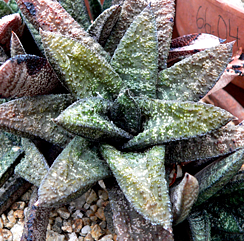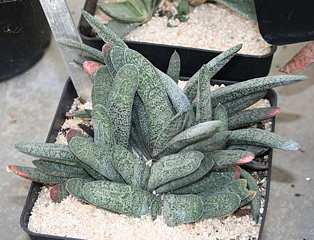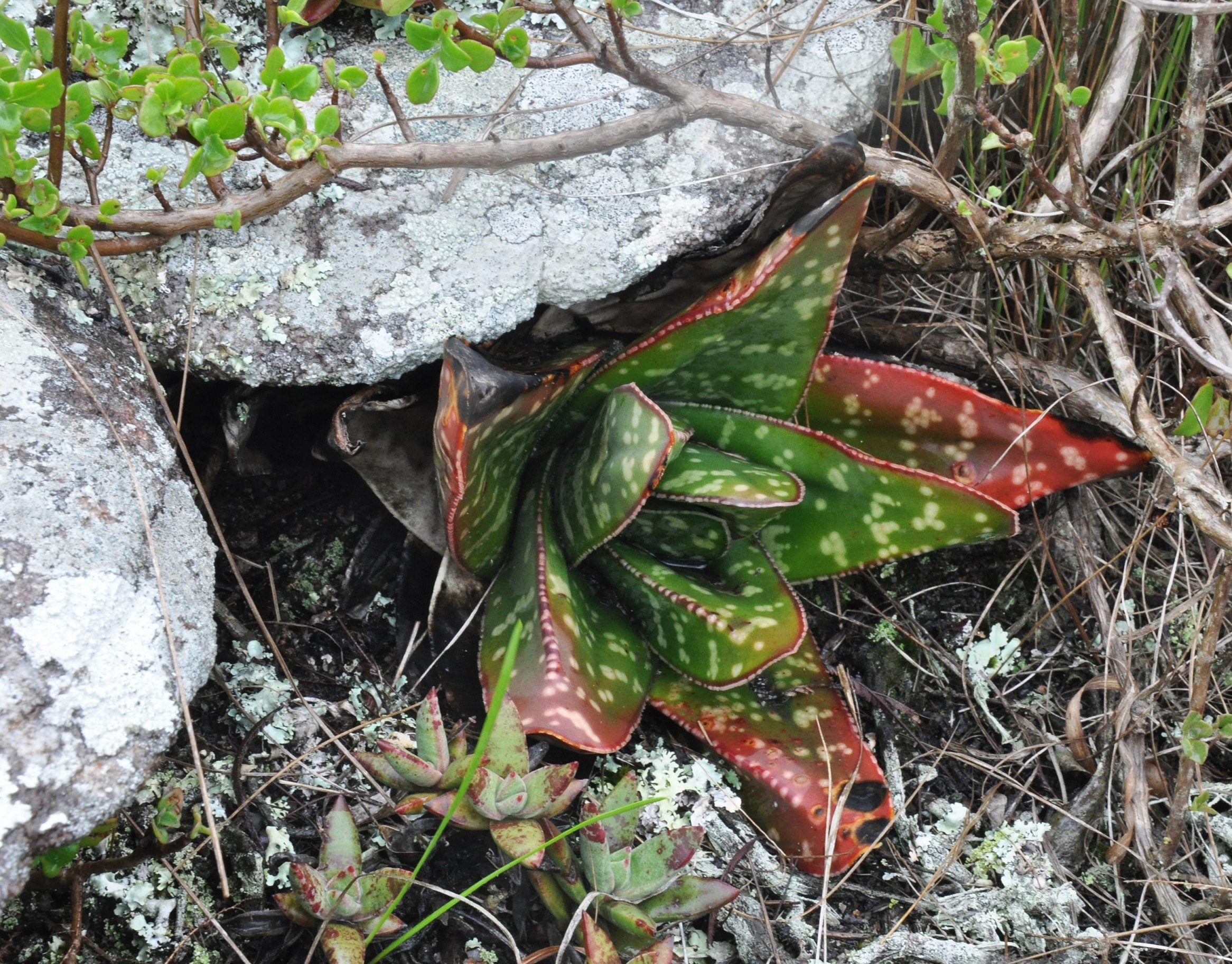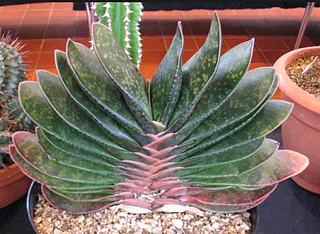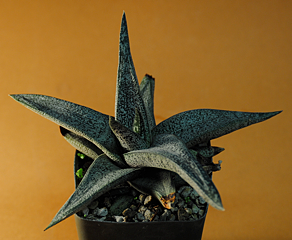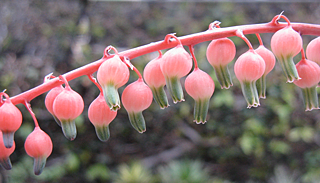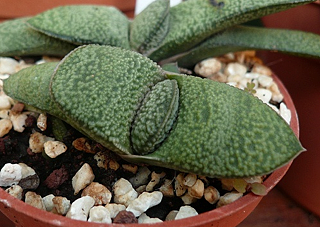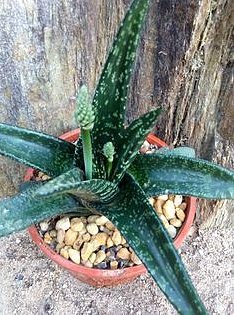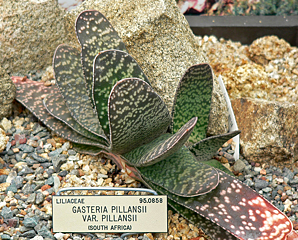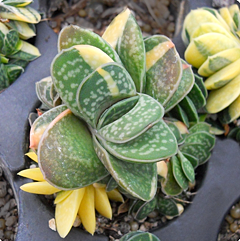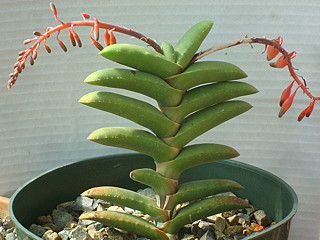Submitted by: Jim Tanner
[Ed: Hybrids between Gasteria and other genera are allowed, including Gasteraloe (=Gastrolea), Gasterhaworthia (=Gasworthia, Gastworthia), Gastrolirion, and Gastroloba. There is an excellent article by Geoff Stein on the Dave’s Garden website at https://davesgarden.com/guides/articles/view/2915]
Gasteria is a genus of succulent plants, native to South Africa (and the far south-west corner of Namibia).
The genus is named for its stomach-shaped flowers (“gaster” is Latin for “stomach”). Common names include ox-tongue, cow-tongue, lawyer’s tongue and, occasionally, mother-in-law’s tongue.
Gasterias are recognisable from their thick, hard, succulent “tongue-shaped” leaves. Their inflorescence is also unique, with their curved, stomach-shaped flowers, which hang from inclined racemes.
The species of this genus are mostly native to the Eastern Cape Province, South Africa, where the bulk of the species occur – especially in the small area between Grahamstown and Uniondale which enjoys rainfall throughout the year. However distribution of several species extends widely across the low-altitude coastal regions of the country, in an arched horseshoe shape across South Africa. At the one end of the genus’s distribution, a species Gasteria pillansii extends into the far south-west corner of Namibia. At the other end, a species reaches the Lebombo mountains of Swaziland.
Gasteria species are grown in well-drained, sandy soils in light shade. The species can all be propagated by off-sets and cuttings (leaf cuttings can usually be rooted easily). They are also commonly propagated by seed. Germination usually occurs within 8 days but may take as long as one month depending on the species.
Gasteria species are prone to Fusarium root rot, if they are over-watered.
Several hybrids with species in other related genera have been created in cultivation, such as between Gasteria and Aloe (×Gasteraloe), and between Gasteria and Haworthia (×Gasterhaworthia).
Gasteria is part of the family Xanthorrhoeaceae, subfamily Asphodeloideae. Closely related genera include Aloe and Haworthia, and the species of these genera are known to hybridise relatively easily with each other.
Dividing Gasteria into species is extremely difficult, as each plant can be highly variable. One plant will look different depending on its location, its soil and its age. Young Gasteria plants typically look entirely different to older specimens. (Usually, young plants have flat, strap-shaped, highly tubercled leaves, in a distichous formation.) In addition, the species tend to flow into each other in gradual transitions, with many intermediate forms, rather than being cleanly divided into discrete and separate species. Lastly, hybrids occur easily and naturally, whenever the range of two species overlap in habitat.
There is therefore considerable disagreement on how many species exist, with as many as 100 names being listed. Current studies tend to agree that there are between 16 and 23 species.
LATIN LOOKUP – Loquerisne Latine (Do you speak Latin)?
The meanings of latin plant names on this page – from http://davesgarden.com/guides/botanary/
- batesiana [bate-see-AH-nuh, bate-see-AY-nuh]
Named for George Latimer Bates, 20th century American ornithologist and botanist in West Africa.. - baylissiana [bay-liss-ee-AH-na]
Named for Colonel Roy Bayliss, a botanical explorer in South Africa and authority on succulents. - disticha [DIS-tik-uh]
1. Two-ranked.
2. leaves erect in a fan shape. - ellaphieae [el-la-FY-aye]
Named for Johanna Ellaphie Ward-Hilorst, 20th century South African botanical artist. - excelsa [ek-SEL-suh]
Tall. - Gasteria [gas-TAIR-ee-uh]
From gaster, (belly, stomach); referring to swollen base on flower. - glomerata [glahm-er-AH-tuh]
Clustered. - gracilis [GRASS-il-is]
Graceful; slender. - liliputana [lil-ee-pyoo-TAH-na]
Tiny. - nitida [NI-ti-duh]
Shiny, glossy. - pillansii [pil-AN-see-eye]
Named for Neville Stuart Pillans, 20th century botanist. - variegata [var-ee-GAY-tuh]
Variegated.
